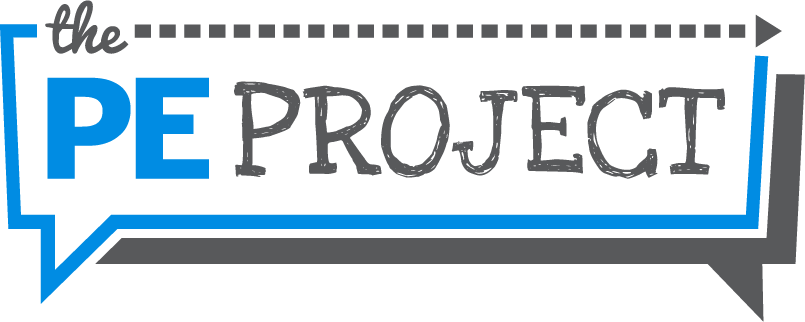
As a PE teacher, effective questioning technique is an essential skill which serves numerous purposes. These include:
- developing listening skills;
- challenging and focusing thinking;
- communicating expectations;
- developing interest and curiosity;
- assessing knowledge and understanding;
- redefining tasks for pupils of differing abilities; and
- helping pupils learn subject-specific terminology in PE [ 1-4 ]

In PE literature the topic of questioning has generally focused on the categorization of convergent and divergent questions and the use of Bloom’s taxonomy for promoting higher-order thinking skills in students. Convergent (or closed) questions generally only have one correct answer which the students should have been taught e.g., “What is a backcourt violation?”. Whereas, divergent (or open) questions allow for more variable and detailed responses e.g., “How could you improve your performance?” [ 1-5 ].

Examples of convergent (closed) and divergent (open) questions
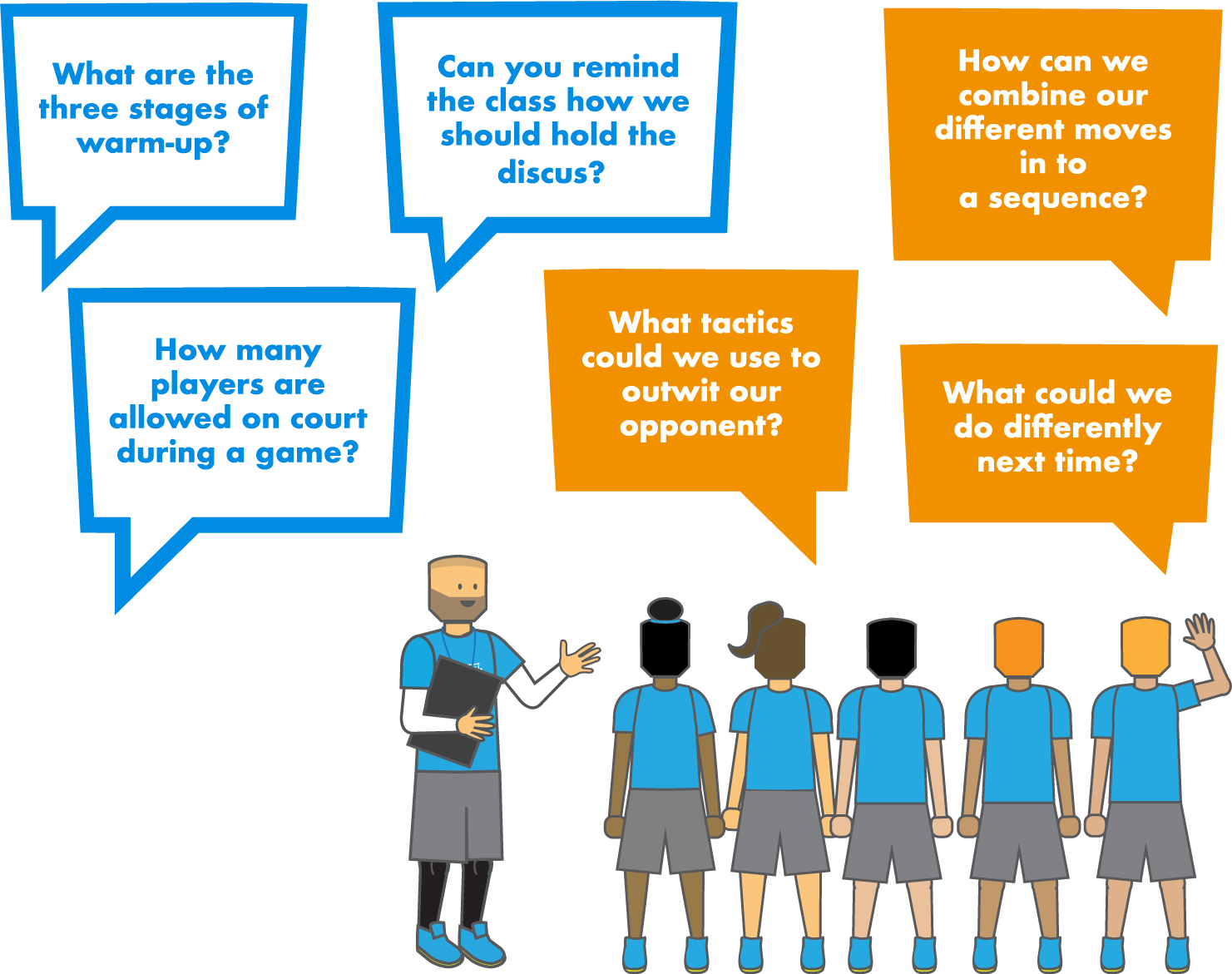
In terms of cognitive complexity, convergent questions usually require lower-order thinking skills whilst divergent questions can stimulate higher-order thinking [ 1 ]. Bloom’s taxonomy of educational objectives provide a useful framework for planning questions which promote higher-order thinking skills (table 1) [ 6 ].
Table 1: Bloom’s taxonomy of higher-order thinking skills used for questioning
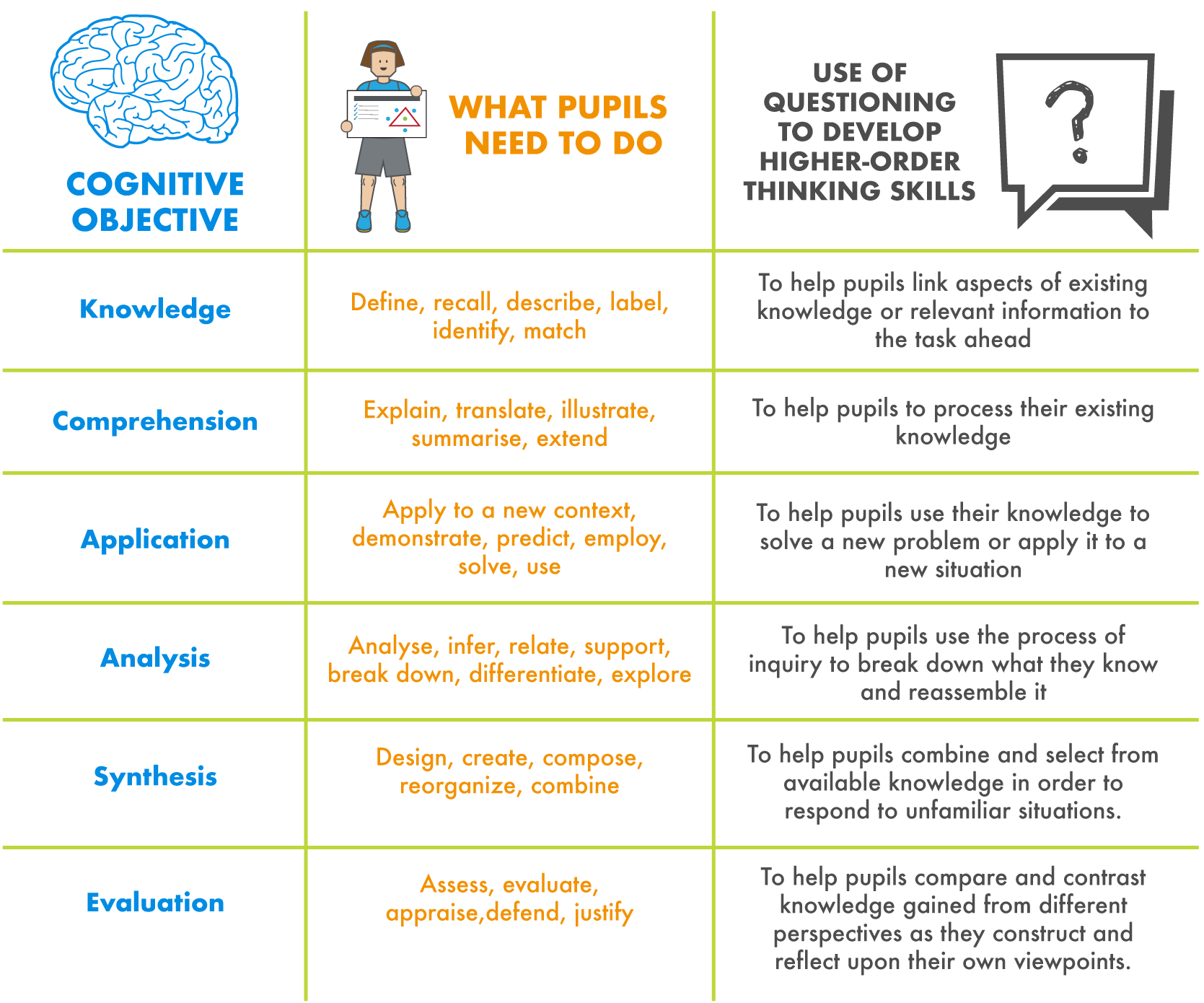
It is important as a PE teacher to plan for both convergent and divergent questions, as lower-order questions encourage students to recall factual knowledge such as recalling the location of muscles or specific teaching points. Whilst higher-order thinking questions might ask students to design a series of exercises that uses the specified muscle [ 1, 7 ]. It is worth noting that you should avoid asking too many divergent questions as they will slow the pace of the lesson [ 2 ]. Therefore, an effective strategy is to focus on the lesson objectives and plan a combination of questions (i.e., 2 closed, 1 open ) which scaffold upon each other [ 8 ].

When asking such questions, Muijs and Reynolds (2011), suggests giving pupils at least 3 seconds thinking time for convergent/closed questions , and 15 seconds for divergent/open questions . One simple strategy to help engage pupils in questioning is 'Think, Pair, Share' - the teacher poses the question and gives pupils thinking time. Students then share their answers with a partner. Teacher then selects students to share answers with the class.
No matter how experienced or inexperienced you are as a teacher, asking effective questions is a skill that can be developed and fine-tuned throughout your teaching career [ 2 ]. If this is a skill that you wish to develop, we recommend that you include relevant questions in your lesson plans and familiarize yourself with the strategies and common mistakes below.
Table 2. Strategies for effective questioning and common mistakes [ 2, 3, 4 ]
.png)
Questions can be asked at any stage during the lesson and doesn’t always have to be in front of the whole-class. A more beneficial approach is to circulate the group and ask individuals and small groups questions to serve a particular purpose, this may be: to focus attention; to invite inquiry; to assess knowledge and understanding; develop self- and peer-assessment; or to lead pupils to be mindful [ 4 ]. Bailey (2001) related question type to the various stages of the lesson (table 3).
Table 3: Types of questions related to stage of the lesson
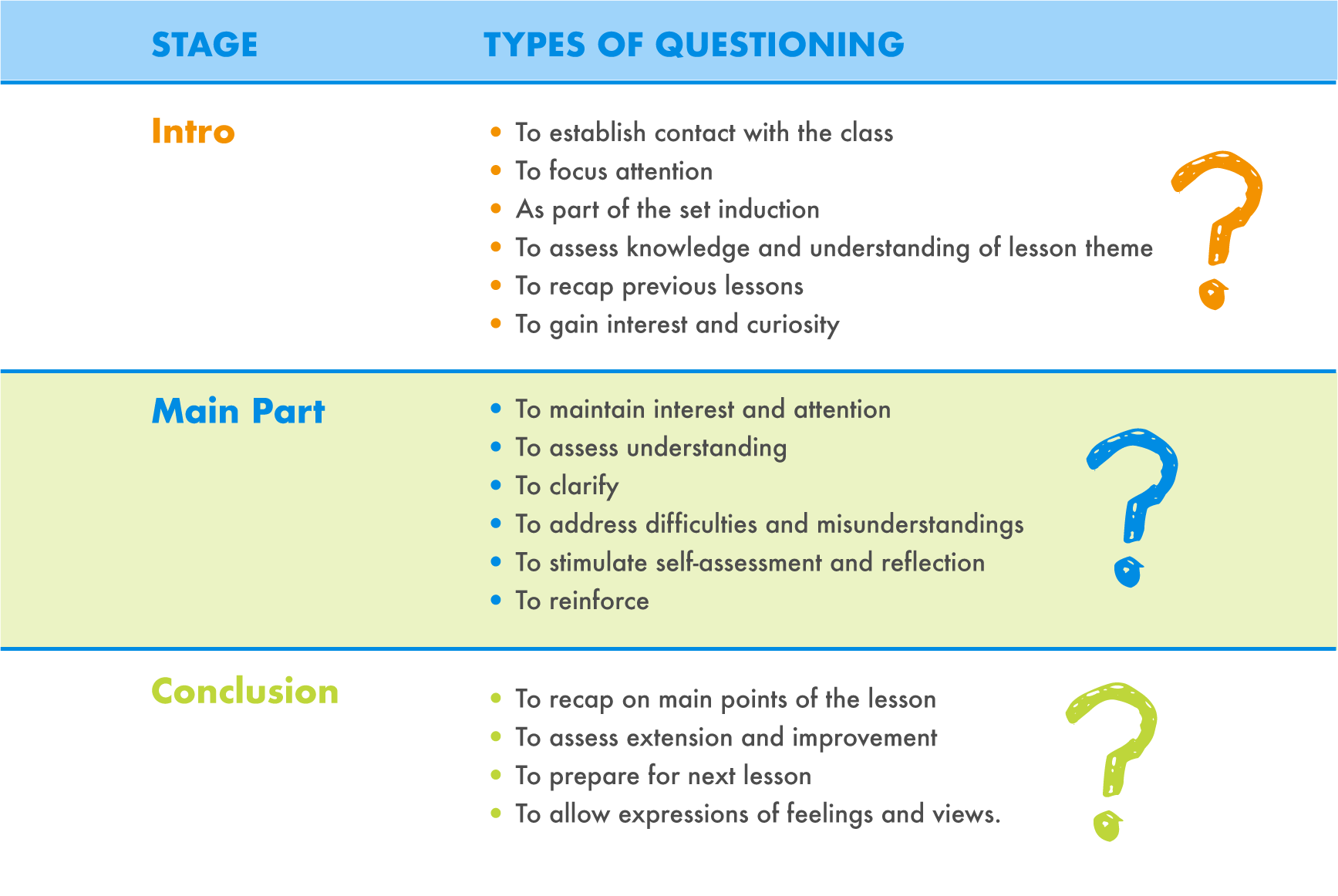
Therefore, in order to skillfully use and ask pertinent questions in Physical Education lessons it is important that you understand and plan a combination of open- and closed- questions which promote the appropriate level of thinking for the different abilities in your class. Print and laminate some of the tables and info above and place them on the wall behind your desk, and try spending 3-minutes thinking about and writing some questions for your lesson. Do this for a handful of lessons in a week and you will be surprised how much better your questioning becomes. But remember to keep it short and punchy!
- Newton, A. & Bowler, M. (2015) Assessment for and of learning in PE, In Capel, S. & Whitehead, M (Ed) Learning to Teach Physical Education in the Secondary School: A Companion to School Experience. 4th Edition. London: Routledge.
- Zwozdiak-Myers, P.N. (2015) Teacher as a researcher/reflective practitioner. In Capel, S. & Whitehead, M (Ed) Learning to Teach Physical Education in the Secondary School: A Companion to School Experience. 4th Edition. London: Routledge.
- Grout, H. & Long, G. (2009) Improving Teaching & Learning in Physical Education. Berkshire: Open University Press
- Bailey, R. (2001) Teaching Physical Education: A handbook for Primary and Secondary School Teachers. London: Kogan Page
- Torrance, H. & Pryor, J. (2001) Developing formative assessment in the classroom: using action research to explore and modify theory. British Educational Research Journal, 27(5): 615-31.
- Bloom, B., Englehart, M.D., Furst, E.J., Hil, W.H. and Krathwohl, D.R. (eds) (1956) Taxonomy of Educational Objectives: The Classification of Educational Goals, Handbook I: Cognitive Domain. New York: D.McKay.
- Good, T.L. & Brophy, J.E.(1991) Looking at Classrooms, Harper Collins: New York.
- Mawer, M (1995) The Effective Teaching of Physical Education, Harlow: Pearson Education.
- Muijs, D. & Reynolds, D. (2011) Effective Teaching: Evidence and Practice. 3rd Edition. London: Sage.

The leader in quality Physical Education, Athletics, and Fitness equipment for 75 years.

- Using Question Techniques for Learning in PE [Interactive]

Questioning techniques are vital to helping students to understand concepts and strategies within physical education. This podcast explores the importance of including questioning techniques as well as my top teaching strategy to allow for more natural questioning!
[0:02] Hey, everyone, on today’s podcast, I want to talk to you about the role and importance of questioning within our job as physical educators, as well as my favorite teaching strategy that you can use to make questioning more of a habit to help your students.
[0:35] In a subject such as physical education, some people out there may argue that utilizing questioning techniques is not necessary or not as important compared to some of the other “academic content areas” within a traditional school setting. To me as physical educators, we have to realize our subject encompasses more than just the psychomotor domain.
Why Utilize Questions in PE?
[0:58] Utilizing questioning techniques in physical education allows for us to connect the brain and the body. When I teach, I want my students to be thinking movers instead of just mindlessly going through the motions. So asking questions in a different way and having students think through possible answers helps to achieve this brain body connection by linking the cycle motor domain of movement to the cognitive and affective domains as well. Posing questions to students also allows for the opportunity for them to discuss with one another, which is a powerful tool in the learning process.
Explore, Pose, Discuss, Refine
[1:29] Throughout the rest of this podcast, I want to share with you my top teaching strategy that allows for more natural questioning within the process, and I call this teaching strategy explore, pose, discuss, refine. And if you’re familiar with experiential learning, that is what this strategy is really based off of.
Explore the Task
[1:49] So the first part of this strategy is Explore. So during this piece, essentially you as a teacher are going to give your students a task to perform and allow them to explore this task in different ways. So in my teaching, I found that starting broad here in relation to the task is often best. So for example, I might tell my students okay, get with a partner, choose an object from the bins in the middle of the gym and go to a spot on the wall together and you can begin taking turns throwing the object off the wall so your partner has to try to catch it and make sure you trade jobs after each throw or catch attempt is made.
Pose a Question
[2:23] So after giving them some time to explore here during the first part of this strategy, we go into the next phase of this strategy, which is pose. During this piece, we’ll kind of stop the class and ask them some questions based upon the experience they just had that’s also tied to the objective of the lesson for the day. So, for an example question maybe if our lesson focuses on force and accuracy, I might pose the question of “how did throwing the ball higher off the wall affect how it rebounded back or lower off the wall? How did that affect how it rebounded back? Or how did the amount of force you used to throw affect how the ball rebounded back?” If our focus is more on the affective domain like teamwork, I might pose the question to them of “what strategies or character traits have helped you and your partner to be successful so far?” These questions should be thought of ahead of time by you as a teacher, as they served to be the main point of dialogue and the next piece of this teaching strategy.
Discuss with a Partner and Group
[3:19] So after posing those questions now it’s time to go into the third part, which is the discussion part. So after you pose these questions, you can have the partners discuss potential answers to these questions together as part of a think, pair, share before asking students to share out. Recording your student’s answers on the board here can help to keep these ideas and suggestions that they come up with in greater focus throughout the rest of your class together, which is really important for the next phase of the strategy. As students share their answers, try to get them to elaborate on what they mean in an attempt to engage them in higher-order thinking.
Refine Performance in Relation to the Question
[3:56] The fourth and final part of this strategy is the refine piece. So after the discussion, have the students go back into the activity as they attempt to refine their performance in relation to the questions and discussions that just took place. So while you’re circulating around and supervising them during this time, you as a teacher can then touch base with students as they are working and even ask them some spin-off questions that help them to continue to think and relate back to the focus of the day.
[4:20] So in conclusion, the explorer, pose, discuss, refine strategy has been one of my favorite teaching strategies to allow for questioning to occur more naturally within my classes. This strategy allows for student voice and collaboration and can work pretty much with any lesson as long as you change the questions to relate to the focus of your day. Try this out within your own teaching and see how it goes. I think both you and your students will enjoy it, too.
One Response
Hi Ross, interesting article in which I am only now delving into as a PE teacher. Have you any suggested reading related to Questioning that you yourself found useful in your own learning. Regards Joe
Leave a Reply Cancel reply
Your email address will not be published. Required fields are marked *

The leader in quality Physical Education, Athletics, and Fitness equipment.
Featured Resources
5 ways small sided games make a big impact, author: jessica shawley, a brand new tool for pe you didn’t know you needed, author: brett fuller, 5 skill-based floor hockey games, author: michael beringer, 16 parachute team building activities, author: tim mueller, we're social, motivating unmotivated students, author: dr. robert pangrazi, jessica shawley, and tim mueller, promoting activity and success through adapted pe, author: dr. robert pangrazi, marci pope and maria corte, author: randy spring.

JOIN OUR NEWSLETTER
Sign up to receive the latest physical education resources, activities, and more from educational professionals like you straight to your inbox!
- Grades 6-12
- School Leaders
Get our FREE Mother's Day Printable 💐!
What Is Higher-Order Thinking and How Do I Teach It?
Go beyond basic remembering and understanding.
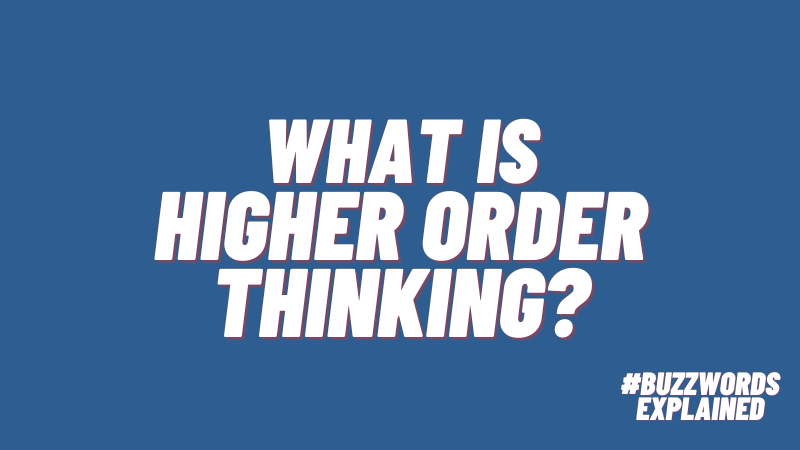
Educators know that people learn in a variety of ways and that we often learn best when we can make connections to the material on a deeper level. That’s why higher-order thinking is such a valuable skill, one that serves students well throughout their school years and beyond. But what exactly does the term mean? And how can teachers build higher-order thinking skills in their students? Learn what you need to know here.
What is higher-order thinking?

Source: Vanderbilt University
Higher-order thinking refers to the top levels of cognitive thinking, as laid out in the Bloom’s Taxonomy model. When we use higher-order thinking, we push beyond basic memorization and recall to analyze and synthesize information. These are the skills that help us evaluate information and think critically. We also use these skills to develop new ideas and concepts, building on previous knowledge to create something entirely new.
Bloom’s Taxonomy
Benjamin Bloom headed a team of educational researchers in the 1950s and led the development of the model that bears his name today. He and his team broke cognitive thinking into six levels, shown as a pyramid. The bottom levels provide the foundation for the higher-order thinking skills at the top.
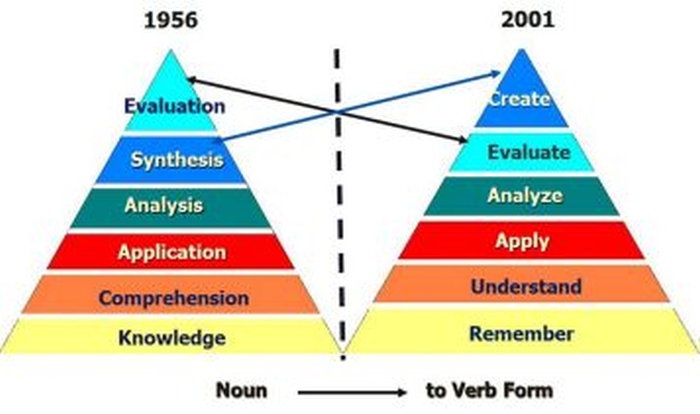
Source: Revised Bloom’s Taxonomy/University of Michigan
If you first learned about Bloom’s Taxonomy more than 20 years ago, it looked a little bit different. In 2001, education experts decided to revise the taxonomy to make it more accurate and easier for educators to understand and apply. They changed the category names from nouns to verbs, showing the action learners would take for each. And they determined that the top two tiers should actually be switched, making “Create” (Synthesis) the highest order of thinking.
Learn more about the history and development of Bloom’s Taxonomy here.
What are the Lower-Order Thinking Skills (LOTS)?

Source: Lower-Order Thinking Skills/Helpful Professor
The bottom three levels of Bloom’s Taxonomy are referred to as the Lower-Order Thinking Skills (LOTS). It’s important to note that even though these skills are considered lower on the pyramid, they’re still extremely important. Think of these as the foundational skills students must have to support their higher-order thinking.
These are skills like memorizing math facts, defining vocabulary words, or knowing the main characters and basic plot points of a story. This is the kind of information you can check using flash cards, spelling tests, true/false questions, and more. There are many basic facts that kids must master so they can quickly recall them as needed.
Check out 21 Ways To Build Background Knowledge to learn more.
When you understand a concept, you can explain how it works to someone else. True understanding is more than memorization or reciting facts. It’s the difference between a child reciting by rote “one times four is four, two times four is eight, three times four is twelve,” versus recognizing that multiplication is the same as adding a number to itself a certain number of times. This is why we often ask students to “show their work” or “show their thinking” on math tests.
See 20 Ways To Check for Understanding for more information.
When you apply your knowledge, you take a concept you’ve already mastered and apply it to new situations. For instance, a student learning to read doesn’t need to memorize every word. Instead, they use their skills in sounding out letters to tackle each new word as they come across it.
Explore 25 Easy Ways To Make Math Practice Fun here.
Which levels constitute higher-order thinking skills (HOTS)?

Source: Higher-Order Thinking Skills/Helpful Professor
The top three levels make up the Higher-Order Thinking Skills (HOTS), also known as critical thinking skills . When students use these skills, they delve deeper into information. Rather than simply accepting facts, they explore the reasons behind them and make cause-and-effect connections. They evaluate the validity of facts and use them to synthesize new concepts, ideas, and inventions.
When we analyze something, we don’t take it at face value. Analysis requires us to find facts that stand up to inquiry. We put aside personal feelings or beliefs, and instead identify and scrutinize primary sources for information. This is a complex skill, one we hone throughout our entire lives. When students compare and contrast multiple concepts, sort and categorize, or ask “why” questions, they’re analyzing.
Try these 25 Cause-and-Effect Lesson Plans and Activities to help kids analyze information.
Evaluating means reflecting on analyzed information, selecting the most relevant and reliable facts to help us make choices or form opinions. True evaluation requires us to put aside our own biases and accept that there may be other valid points of view, even if we don’t necessarily agree with them. Students evaluate when they debate topics, write persuasive essays, assess their own or others’ writings, and more.
Use these 35 Strong Persuasive Writing Examples to show students how evaluation works in practice.
At the highest level, students take the facts that they’ve mastered, evaluated, and analyzed, and use them to create something entirely new. This might be designing a science experiment, building a computer program, writing a paper putting forth new ideas, authoring a story or making art, and other creative activities.
Discover 40 Ways To Make More Time for Creativity in Your Lesson Plans .
Why is it so important to teach higher-order thinking?
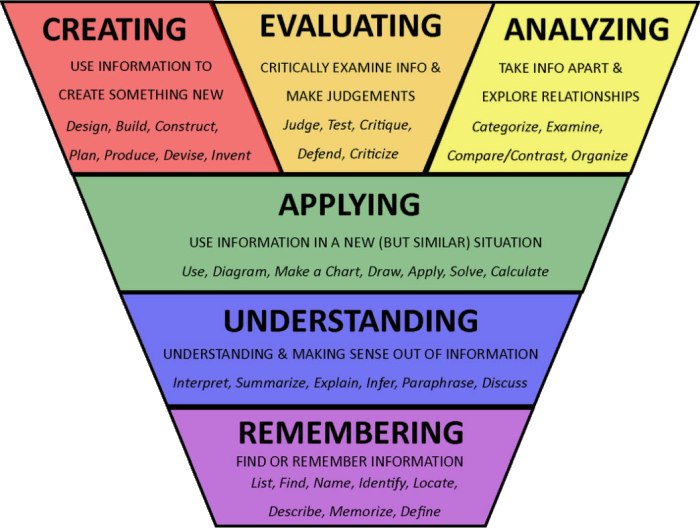
Source: Equal Levels/University of Michigan
While remembering, understanding, and applying are key skills, they don’t really develop students into lifelong learners and critical thinkers. As kids often point out, if they need to know the date of the start of the American Civil War or the third law of motion, they can just look it up in a book or online.
What really matters is what we do with the information we have. Higher-order skills are the ones people use in daily life to make informed decisions and create new products and processes. They help us think critically, something that’s incredibly vital in this age of constant information overload.
When we teach higher-order thinking skills, we give students the ability to solve problems, develop creative solutions, make smart choices, and evaluate the validity of information. Kids grow into adults who understand how to think carefully about the world and feel confident enough to share their own ideas, concepts, and creations with others.
Read more about the importance of higher-order thinking here.
How do I teach higher-order thinking?
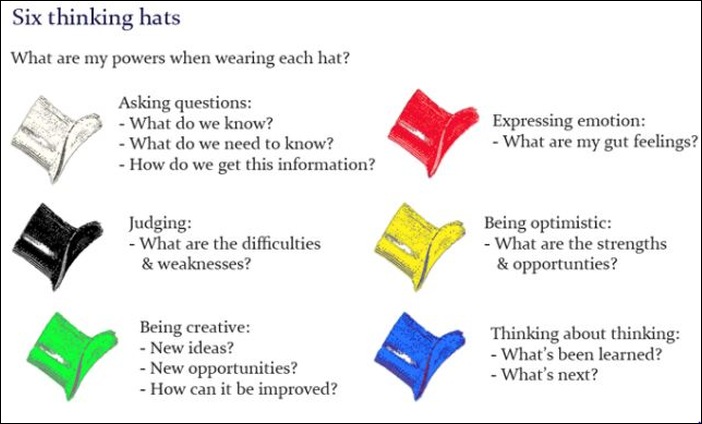
Source: The IDEA Lab
There are a multitude of ways to encourage higher-order thinking in your students. While some say that kids don’t really begin to develop these skills until upper elementary, others argue that it’s never too soon to challenge kids to make connections and ask questions. You can tweak these quick higher-order thinking strategies to work in any classroom, no matter the age or subject.
1. Ask higher-order thinking questions.
Keep a list of higher-order thinking questions on hand, and use them regularly in class. Consider making a bulletin board or anchor chart with some of your favorites, and refer kids to it as they learn. Get a huge list of higher-order thinking questions here.
2. Encourage discussion and debate
When kids learn to disagree respectfully and argue their own opinions using facts to back their beliefs, they’re preparing to take part in the discourse of the world at large. Encourage those with conflicting points of view to share them in your classroom, and teach kids how to analyze and evaluate those points though discussion and debate. Try these resources:
- 60 Funny Debate Topics for Kids of All Ages
- 100 Winning Debate Topics for Middle School Students
- 100 High School Debate Topics To Engage Every Student
- 110+ Controversial Debate Topics to Challenge Your Students
- 60 Interesting Persuasive Essay Topics for Kids and Teens
3. Try STEM challenges.
STEM challenges encourage kids to come up with their own unique answers to problems. They use their knowledge and understanding of science, technology, engineering, and math to analyze and evaluate the challenge and create new solutions. Start with these 50 STEM Activities To Help Kids Think Outside the Box . Then, visit our archive of STEM challenges and science experiments for ideas .
4. Use graphic organizers.
Graphic organizers are tools that let kids make connections, create a plan, and communicate effectively. A good organizer simplifies complex information and lays it out in a way that makes it easier for a learner to digest. Graphic organizers may include text and images, depending on the purpose and student’s learning style. Read all about graphic organizers and learn how to use them here.
5. Incorporate project-based learning.
Project-based learning uses HOTS like analysis and evaluation, collaboration and communication, and problem-solving. As students conduct their hands-on projects, they dig deeper into a real-world topic and make personal connections to the knowledge and skills they’re gaining. In many ways, PBL is more like the work adults do in their daily jobs, especially because students collaborate with others outside their school community. Discover the basics of project-based learning here , then check out 55+ Real-World Project-Based Learning Ideas for All Ages and Interests .
Have more questions about higher-order thinking? Come talk it over with other educators in the WeAreTeachers HELPLINE group on Facebook .
Plus, what is critical thinking and why do we need to teach it .
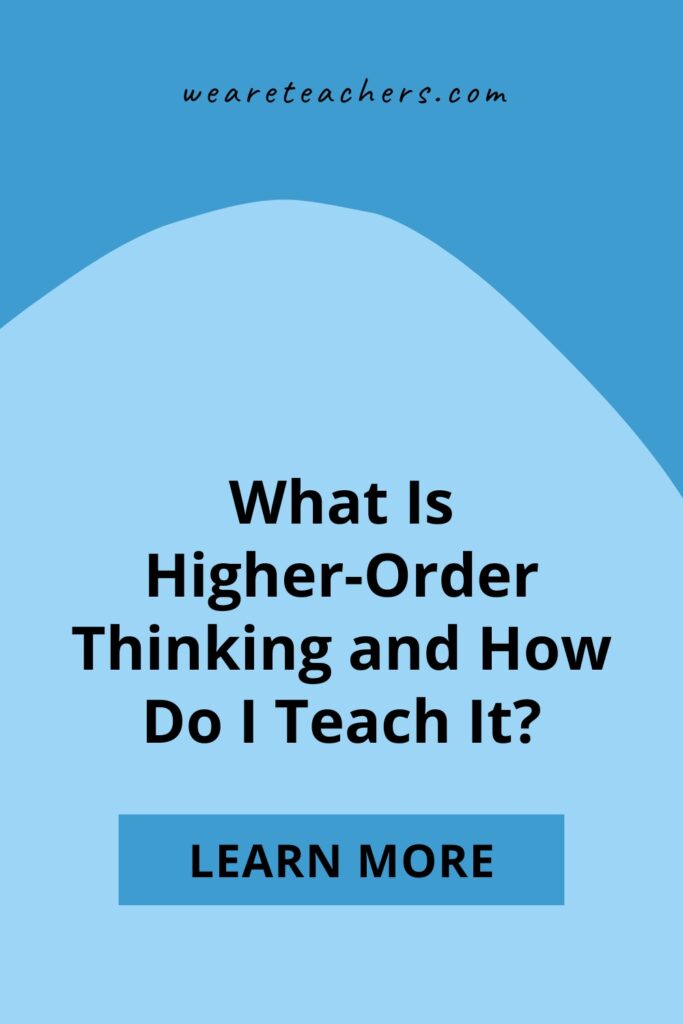
You Might Also Like
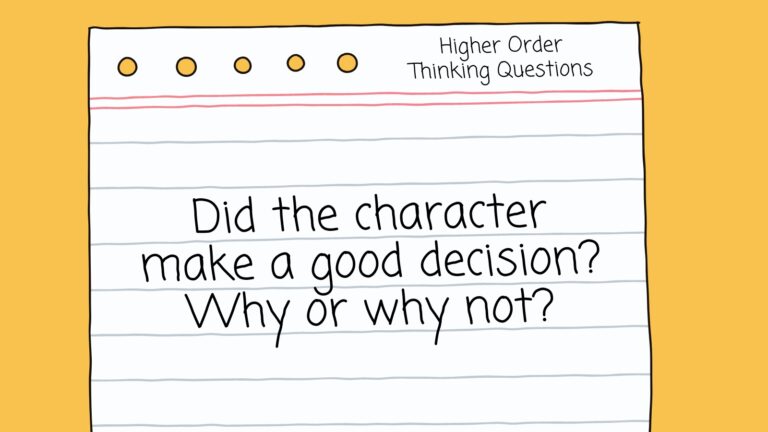

50+ Higher-Order Thinking Questions To Challenge Your Students
50+ lower order thinking questions too! Continue Reading
Copyright © 2024. All rights reserved. 5335 Gate Parkway, Jacksonville, FL 32256
Top Nav Breadcrumb
- Ask a question

Thinking skills in physical education
Thomas Courcoux, primary PE teacher, Atlanta International School, USA
This article demonstrates how the development of thinking skills can help build a bridge between subjects such as physical education and social studies. Through a contemporary dance approach, the author supports students’ creativity and leads them to express their understanding of the unit ‘Sharing the planet’ in a meaningful way.
In physical education (PE) class, we have been using a number of thinking routines to increase engagement and deepen the student’s understanding of a unit of inquiry. Through an overview of my 5th grade during a contemporary dance unit, students discovered how their thinking in PE can be a source of inspiration in order to create their shapes and moves connected to the unit of inquiry Sharing the planet . PE became an integral part of a transdisciplinary learning journey thus building a bridge between classroom teachers and specialists.
With my 5th grade in dance, I wanted them to have a physical experience that goes beyond reproducing shapes, steps and moves. I want them to see their body as a way to express themselves, and therefore I felt that a contemporary dance fits this aim. However, when you tell students and teachers that this dance unit will be based on a contemporary approach, it does not always excite them! How can we reach this goal without taking the risk of having our students becoming unmotivated or blocked? How can the unit of inquiry be a source of inspiration for their dance, and how can the dance lead them to a better understanding about the central idea?
We have been using thinking routines, to help students have ownership of their work, so that they confidently discuss, choose and create their own moves in contemporary dance. This leads them to uncover deeper thinking and express themselves in a meaningful way using their own body.
The central idea for the Sharing the planet unit is “Human migration is a response to challenges, risks, and opportunities”. This unit has been introduced by the classroom teachers through thinking activities using migration pictures displayed in the hallway. In coordination with the classroom teachers, we agreed that in order to get the maximum benefit of this introduction and develop students’ transfer skills, it would be beneficial to use the same thinking routines in PE. So I created a similar gallery in the gym by placing different migrations pictures on gym mats. I asked my students to take post-it notes and move around this gallery to take notes of all the words that were coming to their minds. I used a “I See, Think, Wonder…” routine from Harvard Project Zero , which my students were already familiar with.
Next, my students shared in small groups the words, questions and ideas they came up with. I asked them to keep only four words, so they collectively debated on which words they wanted to keep, which helped them strengthen their collaboration skills.
The following step was to ask my students to create three shapes and one move, each expressing one of the four words. To achieve that, I asked my students to use another thinking routine, “Step inside”, which invited them to “step inside the shoes of a migrant”.
Besides this on-going work in small groups, we came up with the idea of reproducing a migration in the gym. My students stepped in the shoes of a migrant and started to walk slowly around the gym, following each other. This migration walk was the common thread of the 8-minute choreography, and the body shapes and moves were the points of understanding that my students wanted to highlight through this dance unit.
My students performed this dance two times in front of the school community. During the questions and answers session that followed, it was amazing to see how they were able to explain their choices by connecting with their understanding about the central idea. When a grade one student asked “why were you covering your eyes or mouths?”, the fifth grade students connected these body shapes with their understanding about how being a migrant leads to some tough situations we do not want to see, and how you may not have the right to raise your voice.
At the end of the unit, and to reflect on their understanding about the contemporary dance approach in PE, I invited my students to use the thinking routine “I used to think…Now I think…”. I split my whiteboard in two parts, one for “I used to think…” and the second one for “Now I think…”. With two post-it notes, each student wrote their perspectives about contemporary dance before and after this unit. By looking closely at the post-its, the students could realize how their thinking about body expression has shifted. They were more inclined to explore the body as a way to express themselves.
This unit has been inspiring for both students and teachers and brought a rich perspective regarding the role of PE within a transdisciplinary programme. The contemporary approach of the dance, as well as the student agency and the use of thinking routines seem to be some of the key points that led to a successful project.
References:
Harvard Project Zero, from Harvard Graduate School of Education: http://www.pz.harvard.edu/
Creativity routines: Step Inside: Perceive, Know, Care about : A routine for getting inside perspectives
Ritchhart, R, Church, M, & Morrison, K (2011). Making Thinking Visible: How to Promote Engagement, Understanding, and Independence for All Learners
Thomas Courcoux is a French citizen, currently PE teacher at Atlanta International School . He has held several positions in France, India and now in the USA. He holds an ‘agrégation’ in physical education and a bachelor’s in physical education from the University of Rennes-Brittany. He also holds a Master’s of Learning Sciences, Comparative and International Education from the University of Paris-Descartes and has developed a high interest in curriculum comparisons. Thomas enjoys exploring teaching approaches that go beyond teaching physical skills, looking at the student in a holistic approach. You can follow him on Twitter @TomCcx .
PE , physical education , Sharing the planet
3 Responses to Thinking skills in physical education
Inspired! Will share this tomorrow with the PE teacher in the school where I’m teaching a professional development course on thinking strategies and routines tomorrow.
This is amazing — I’m sharing this with my TK-8 staff.
I am the VP of dance for our state organization in Louisiana. I came across your research integrating dance into Physical Education. This is a piece of LAHPERD we are trying to improve. We are currently looking for presenters for our state conference in November 2021. Would you have any recommendations?
Leave a Reply
You must be logged in to post a comment.
This site uses Akismet to reduce spam. Learn how your comment data is processed .
About the IB
The International Baccalaureate (IB) is a global leader in international education—developing inquiring, knowledgeable, confident, and caring young people. With more than 7,700 programmes being offered worldwide, across over 5,600 schools in 159 countries, an IB education is designed to develop well-rounded individuals who can respond to today’s challenges with optimism and an open mind. For over 50 years, our four programmes provide a solid, consistent framework and the flexibility to tailor students’ education according to their culture and context. To find out more, please visit www.ibo.org.
SINTA CERTIFICATE
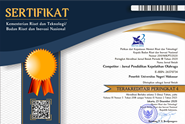
Science and Technology Index Score 4
SUBMISSION
- Author Guideline
- Online Submission
- Plagiarism Checker
JOURNAL INFO
- Focus and Scope
- Editorial Board
- Reviewer Team
- Section Policies
- Peer Review Process
- Open Access Policy
- Journal Archiving
- Publication Ethic
- Author Fees
ISSN BARCODE
ISSN Online
ISSN Print
View My StatCounter
- Other Journals
- For Readers
- For Authors
- For Librarians
USE THIS CITATION INDEX
FLAG COUNTER
IN ASSOCIATION WITH
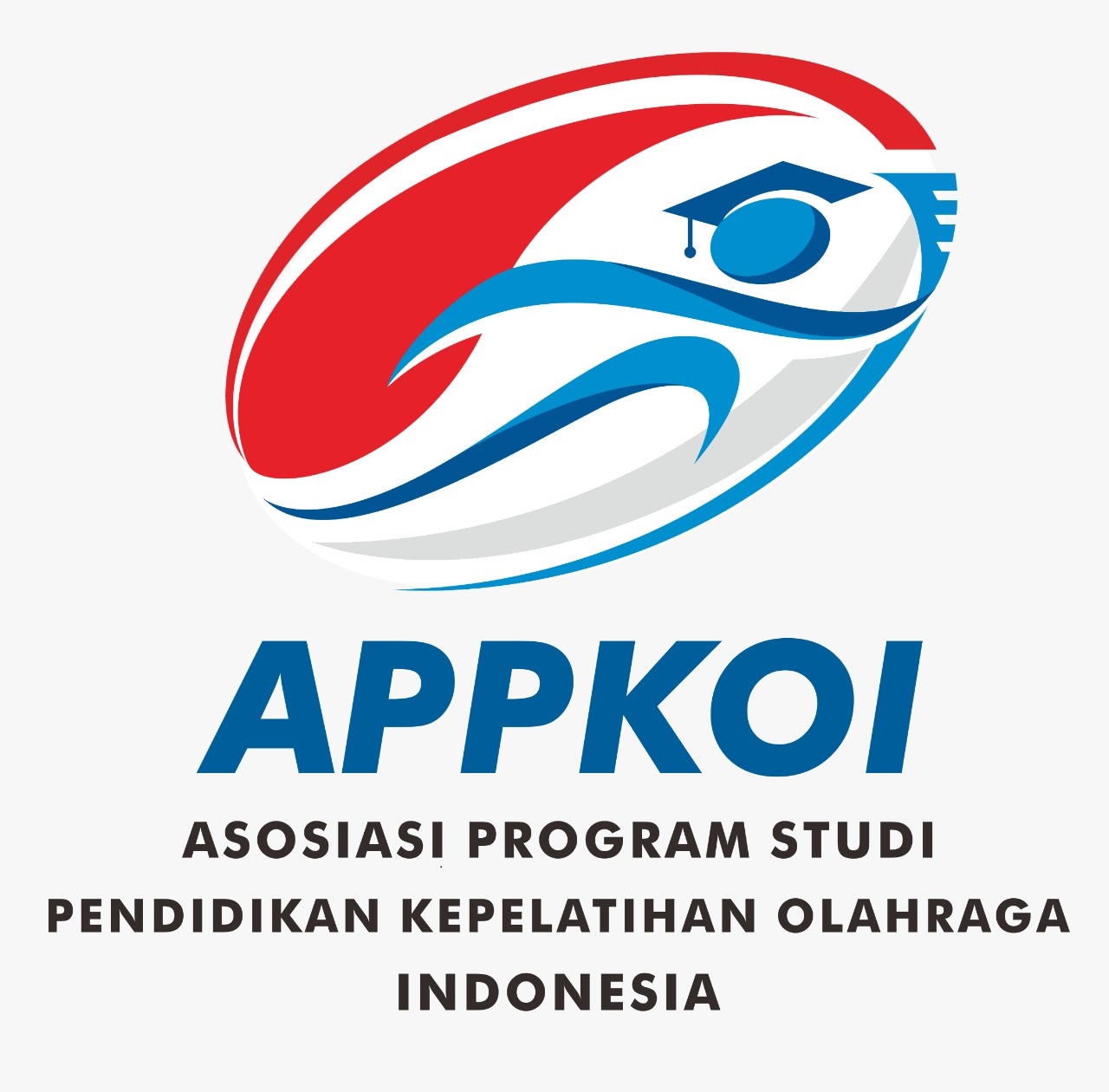
- Announcements
Implementation of Higher Order Thinking Skills In Physical Education Learning In Covid-19 Era: Is It Work?
This study aims to determine how well the implementation of Higher Order Thinking Skills (HOTS) based on Physical Education at Banyumas Regency in 2020. This type of research is a quantitative descriptive study using a survey method. The population in this study were all physical education teachers in Banyumas Regency, totaling 29 teachers, who were taken using the total sampling technique. The data collection technique used a questionnaire. The data analysis technique used percentage descriptive analysis. The results showed that the implementation of Higher Order Thinking Skills (HOTS) based Physical Education at Banyumas Regency in 2020 was in the "very poor" category of 0.00% (0 teachers), "less" of 51.72% (15 teachers), " enough "by 48.28% (14 teachers)," good "by 0.00% (0 teachers), and "Very good" by 0.00%. From these results, can be concluded that the implementation of Higher Order Thinking Skills (HOTS) based Physical Education at Banyumas Regency in 2020 was less category. This is certainly an evaluation so that the implementation of the 2013 curriculum can be further improved so that learning objectives can be achieved properly.
Abdullah, A. H., Abidin, N. L. Z., & Ali, M. (2015). Analysis of students’ errors in solving Higher Order Thinking Skills (HOTS) problems for the topic of fraction. Asian Social Science, 11(21), 133–142. https://doi.org/10.5539/ass.v11n21p133.
Arikunto, S. (2013). Prosedur Penelitian : Suatu Pendekatan Praktik (Edisi Revisi). In Jakarta: Rineka Cipta. https://doi.org/10.1017/CBO9781107415324.004.
Brevik, L. M., Blikstad-Balas, M., & Engelien, K. L. (2017). Integrating assessment for learning in the teacher education programme at the University of Oslo. Assessment in Education: Principles, Policy and Practice, 24(2), 164–184. https://doi.org/10.1080/0969594X.2016.1239611.
Festiawan, R. (2015). Pedagogi Olahraga (Sport Pedagogy). Universitas Jenderal Soedirman, 1–23.
Festiawan, R. (2020). Belajar dan Pendekatan Pembelajaran. 2020, 1–17. https://osf.io/mpng9/download.
Festiawan, R., Ngadiman, N., Kusuma, I. J., Nurcahyo, P. J., & Kusnandar, K. (2019). Pengembangan Model Pembelajaran Pendidikan Jasmani Berbasis Games, Education, and Visualisation (GEV) Untuk Meningkatkan Pengetahuan Kesehatan Reproduksi Remaja. Jendela Olahraga, 4(2), 13–25. https://doi.org/10.26877/jo.v4i2.3678.
Fuad, N. M., Zubaidah, S., Mahanal, S., & Suarsini, E. (2017). Improving junior high schools’ critical thinking skills based on test three different models of learning. International Journal of Instruction, 10(1), 101–116. https://doi.org/10.12973/iji.2017.1017a.
Gunawan, I. (2017). Indonesian Curriculum 2013: Instructional Management, Obstacles Faced by Teachers in Implementation and the Way Forward. Advances in Social Science, Education and Humanities Research, 128(ICET), 56–63. https://doi.org/10.2991/icet-17.2017.9.
Ichsan, I. Z., Rahmayanti, H., Purwanto, A., Sigit, D. V., Singh, C. K. S., & Babu, R. U. M. (2020). HOTS-AEP-COVID-19: Students Knowledge and Digital Worksheet of ILMIZI Environmental Learning Model. International Journal of Advanced Science and Technology, 29(6), 5231–5241.
Ichsan, I. Z., Sigit, D. V., Miarsyah, M., Ali, A., Arif, W. P., & Prayitno, T. A. (2019). HOTS-AEP: Higher order thinking skills from elementary to master students in environmental learning. European Journal of Educational Research, 8(4), 935–942. https://doi.org/10.12973/eu-jer.8.4.935.
Ichsan, I. Z., Sigit, D. V., Miarsyah, M., Ali, A., Suwandi, T., & Titin. (2020). Implementation supplementary book of green consumerism: Improving students hots in environmental learning. European Journal of Educational Research, 9(1), 227–237. https://doi.org/10.12973/eu-jer.9.1.227.
Jailani, J., Sugiman, S., & Apino, E. (2017). Implementing the problem-based learning in order to improve the students’ HOTS and characters. Jurnal Riset Pendidikan Matematika, 4(2), 247. https://doi.org/10.21831/jrpm.v4i2.17674.
Kamaludin, Ngadiman, Festiawan, R., Kusuma, I. J., & Febriani, A. R. (2020). Pengembangan Permainan Pecah Piring Sintren : Pemanfaatan Olahraga Tradisional Pada Pembelajaran untuk Meningkatkan Kemampuan Motorik Kasar Anak. TEGAR: Journal of Teaching Physical Education in Elementary SchoolJournal of Teaching Physical Education in Elementary School, 3(5), 37–45.
Kim, L. E., Jörg, V., & Klassen, R. M. (2019). A Meta-Analysis of the Effects of Teacher Personality on Teacher Effectiveness and Burnout. Educational Psychology Review, 31(1), 163–195. https://doi.org/10.1007/s10648-018-9458-2.
Kogoya, T., Mutohir, C., Pramono, M., & Festiawan, R. (2021). Application Of Cooperative Learning Models Jigsaw Type For Improving Learning Outcomes Groundstroke Forehand Tonnis. Ann Trop Med & Public Health, 24(3). https://doi.org/https://doi.org/10.36295/ASRO.2021.24370.
Lin, T. J., Lin, T. C., Potvin, P., & Tsai, C. C. (2019). Research trends in science education from 2013 to 2017: a systematic content analysis of publications in selected journals. International Journal of Science Education, 41(3), 367–387. https://doi.org/10.1080/09500693.2018.1550274.
Narayanan, S., & Adithan, M. (2015). Analysis Of Question Papers In Engineering Courses With Respect To Hots (Higher Order Thinking Skills). American Journal of Engineering Education (AJEE), 6(1), 1–10. https://doi.org/10.19030/ajee.v6i1.9247.
Ngadiman, Kusuma, I. J., & Festiawan, R. (2019). Sport Development Index Of Banyumas Regency. Jurnal Pendidikan Jasmani Dan Olahraga, 4(2), 193–197. https://doi.org/10.17509/jpjo.v4i2.19181.
Nurcahyo, P. J., Festiawan, R., Yoda, I. K., Wijayanto, A., & Gustiputungurahadi, I. (2021). Study In Banyumas District : Is The Learning Materials Of Football In School Already Oriented To High Order Thinking Skill ? Ann Trop Med & Public Health, 24(3). https://doi.org/https://doi.org/10.36295/ASRO.2021.24366.
Pratama, G. S., & Retnawati, H. (2018). Urgency of Higher Order Thinking Skills (HOTS) Content Analysis in Mathematics Textbook. Journal of Physics: Conference Series, 1097(1), 1–8. https://doi.org/10.1088/1742-6596/1097/1/012147.
Retnawati, H., Hadi, S., & Nugraha, A. C. (2016). Vocational high school teachers’ difficulties in implementing the assessment in curriculum 2013 in Yogyakarta Province of Indonesia. International Journal of Instruction, 9(1), 33–48. https://doi.org/10.12973/iji.2016.914a.
Sugiyono. (2016). Metode penelitian kuantitatif, kualitatif, dan R&D. Bandung: Alfabeta.
Tyas, E. H., & Naibaho, L. (2021). Hots Learning Model Improves the Quality of Education. International Journal of Research -GRANTHAALAYAH, 9(1), 176–182. https://doi.org/10.29121/granthaalayah.v9.i1.2021.3100.
Van der Kleij, F. M., Cumming, J. J., & Looney, A. (2018). Policy expectations and support for teacher formative assessment in Australian education reform. Assessment in Education: Principles, Policy and Practice, 25(6), 620–637. https://doi.org/10.1080/0969594X.2017.1374924.
Wechsler, S. M., Saiz, C., Rivas, S. F., Vendramini, C. M. M., Almeida, L. S., Mundim, M. C., & Franco, A. (2018). Creative and critical thinking: Independent or overlapping components? Thinking Skills and Creativity, 27(December 2017), 114–122. https://doi.org/10.1016/j.tsc.2017.12.003.
Wicaksono, P. N., Kusuma, I. J., Festiawan, R., & Widanita, N. (2020). Evaluasi penerapan pendekatan saintifik pada pembelajaran pendidikan jasmani materi teknik dasar passing sepak bola Evaluation of application of scientific approach in physical education learning basic technical material for football passing. Jurnal Pendidikan Jasmani Indonesia, 16(1), 41–54. https://doi.org/https://doi.org/10.21831/jpji.v16i1.29774.
Widana, I. W., Suarta, I. M., & Citrawan, I. W. (2019). Work motivation and creativity on teacher ability to develop HOTS-based assessments. International Journal of Social Sciences and Humanities, 3(3), 188–200.
Widiatsih, A., Wardani, D. A. R., Royhana, U., Djamali, F., & Septory, B. J. (2020). The development of mathematical problem based on Higher Order Thinking Skill (HOTS) on comparative material by implementing PBL and its effect on the teacher’s creative thinking skill. Journal of Physics: Conference Series, 1538(1), 1–11. https://doi.org/10.1088/1742-6596/1538/1/012110.
Yuliati, S. R., & Lestari, I. (2018). Higher-Order Thinking Skills (Hots) Analysis of Students in Solving Hots Question in Higher Education. Perspektif Ilmu Pendidikan, 32(2), 181–188. https://doi.org/10.21009/pip.322.10.
Yustifar, A., Rachman, H. A., Festiawan, R., Yoda, I. K., & Suwiwa, I. G. (2021). The Application Of Problem-Based Learning In Physical Educations To Improve Learning Outcomes A Game Of Volleyball Class X Sma N 1 Sleman. Ann Trop Med & Public Health, 24(3). https://doi.org/http://doi.org/10.36295/ASRO.2021.24320.
- There are currently no refbacks.

COMPETITOR EDITORIAL LOCATION :
COMPETITOR IS INDEXED BY

Higher order thinking
This page provides guidance on supporting the high-ability student to develop their higher order thinking skills.
The importance of higher order thinking
It is easy to assume that students who appear to move through tasks quickly have all the skills they need. A teacher may also think these students have little more to develop. Yet, the development of cognitive and metacognitive skills has no ceiling.
There is always more for high-ability students to learn and room for them to grow.
If students exceed curriculum level outcomes, tasks can be made more challenging by targeting higher order thinking. This will set the conditions for students to extend their learning.
What we know
Teachers who plan to teach and extend students' higher order thinking skills promote growth for their high-ability students. Higher order thinking is often used to refer to 'transfer', 'critical thinking' and 'problem solving.' These can be defined as:
- transfer - the student's ability to apply knowledge and skills to new contexts (for example, a student in year 5 learning about fractions applied her knowledge to a real world scenario)
- critical thinking - the ability to reason, reflect, and decide what to believe or do next
- problem solving - meeting a goal that cannot be met with a memorised solution (Brookhart, 2010, 2011).
From theory to practice
Teachers may know some thinking skill taxonomies. These may include:
- Bloom's Revised Taxonomy (remember, understand, apply, analyse, evaluate, create) (Anderson & Krathwohl, 2001)
- Webb's Depth of Knowledge (recall and reproduction, application of skills, strategic thinking, extended thinking) (Webb, 2002).
These models can be used to plan activities that target students' higher order thinking. Focusing on content and skills at the highest level (Level 4 – Extended thinking) can help extend students' thinking skills. Low and high cognitive questions can also be used to target activities towards specific levels of thinking skills.
Strategies and tools
Strategies that teachers may use in their classes to encourage higher order thinking include:
- posing provocative questions, statements or scenarios to generate discussion (for example, the use of 'what if' questions)
- requiring students to explain concepts using analogies, similes and metaphors
- posing problems with no single solution, or that have multiple pathways to a solution
- modelling a range of problem solving strategies
- using concept mapping to assist students to make connections between and within ideas
- creating a makerspace in your classroom to encourage creativity, critical thinking and design thinking
- posing paradoxes for students to consider (for example: In a study of World War 1, students can be presented with the statement: 'War nurses saved lives, but they also contributed to deaths')
- creating an 'I wonder' wall in your classroom
- conducting a Socratic dialogue .
Tools that can assist teachers to encourage higher order thinking include:
- depth of knowledge table (informed by Webb 2002)
- low and high cognitive questions exemplar for reading comprehension
- SOLO taxonomy
Focus questions for professional learning
- How do you, or can you, plan for higher order thinking in your lessons?
- How does higher order thinking support the needs of the high-ability student?
- What thinking skills are considered to be of higher order in the depth of knowledge table?
Anderson, L.W., & Krathwohl, D. (2001). A taxonomy for learning, teaching, and Assessing: A revision of Bloom's Taxonomy of Educational Objectives. Allyn & Bacon, MA (Pearson Education Group).
Brookhart, S. M. (2010). How to assess higher-order thinking skills in your classroom. ASCD.
Fleming, L. (2015). Worlds of making: Best practices for establishing a makerspace for your school. Corwin Press.
Gamwell, P., & Daly, J. (2017). The wonder wall: Leading creative schools and organizations in an age of complexity. Corwin Press.
Webb, N. L. (2002). Depth-of-knowledge levels for four content areas. Language Arts.
Our website uses a free tool to translate into other languages. This tool is a guide and may not be accurate. For more, see: Information in your language
35 Higher-Order Thinking Questions

Higher-order thinking questions are questions that you can ask in order to stimulate thinking that requires significant knowledge mastery and data manipulation.
Generally, higher-order thinking involves thinking from the top 3 levels of bloom’s taxonomy: analysis, evaluation, and knowledge creation.
The term “higher-order” is used because these forms of thinking require strong command of information and the ability to work with it to develop complex understanding (Stanley, 2021).
Generally, a higher-order thinking question will be open-ended and require the student to demonstrate their ability to analyze and evaluate information.
Higher-Order Thinking Questions
Below are some useful questions for stimulating higher-order thinking.
Questions for Teachers to Ask Students
- Encourage compare and contrast: How would you compare and contrast these two concepts/ideas?
- Seek alternatives: Can you provide an alternative solution to this problem?
- Apply an ethical lens: What ethical considerations are involved in this situation or decision?
- Categorize and classify: How would you categorize or classify these items based on their shared characteristics?
- Sort by priority: How would you prioritize these tasks, and what factors did you consider?
- Real-world connections: How can you apply this concept to a real-world situation?
- Rephrase and reframe: How would you rephrase this question or problem from a different perspective?
- Identify trends: Can you identify any trends or developments that may influence this issue in the future?
- Seek solutions: How would you design a solution to address this challenge?
- Use evidence: What evidence supports your point of view or conclusion?
- Find relationships: Can you explain the relationship between these two events or phenomena?
- Change a variable: How would this situation change if we altered this variable or factor?
- Compare to prior knowledge: In what ways does this concept challenge your previous understanding or beliefs?
- Identify connections: Can you explain how these two seemingly unrelated ideas are connected or interdependent ?
- Re-conextualize: How would you adapt this solution to work in a different context or environment?
- Identifying consequences: What are the potential consequences of this decision or action?
- Evaluate: What criteria would you use to evaluate the effectiveness or success of this approach?
- Interdisciplinary connections: How can you apply principles from another discipline to enhance your understanding of this topic?
- Distil key factors: What factors may have contributed to this outcome or result, and how might they be addressed?
- Identifying bias: Can you identify any biases or assumptions in this argument?
- Find weaknesses: How would you argue against your own position or point of view?
- Steelman: Can you think of likely criticisms of your position and identify ways you would respond?
- Make judgments about best practices: Can you develop a set of guidelines or best practices based on this information?
- Seek next steps: What questions would you ask to further investigate or explore this topic?
- Reflect on process: What did you learn about how you went about this task and how would you make changes next time for improvements?
Questions for Students to Ask Themselves
- K-W-L: What do I already know about this topic, what do I still need to learn, and what have I learned today?
- Compare and contrast with prior knowledge: How does this new information relate to what I already know?
- Identify assumptions : What assumptions am I making, and are they justified?
- Organize: How can I organize this information in a way that makes sense to me?
- Identify trends: What patterns or connections can I identify between these concepts or ideas?
- Think from another perspective: Am I considering multiple perspectives or viewpoints in my analysis?
- Brainstorm implications : What are the potential implications of my conclusions or decisions?
- Hypothesize: How can I use my current knowledge to predict or hypothesize about future events?
- Identify inconsistency: Can I recognize any logical fallacies or inconsistencies in my reasoning?
- Seek new strategies: What strategies can I employ to improve my understanding and retention of this material?
Higher-Order Thinking vs Lower-Order Thinking
Benefits of higher-order thinking.
Higher-order thinking offers numerous benefits to learners, including:
- Enhanced problem-solving skills : Higher-order thinking develops a student’s ability to tackle complex problems by breaking them down, analyzing different aspects, and putting the information back together to find new solutions. This is highly valued in 21st Century workplaces (Saifer, 2018).
- Critical thinking and reasoning : Students who engage in higher-order thinking are better equipped to evaluate information, question assumptions, and identify biases. This helps them to have better media literacy and enables them to form independent conclusions rather than being easily swayed by flawed information (Richland & Simms, 2015).
- Creativity and innovation : Higher-order thinking fosters creativity by encouraging students to think beyond the obvious. Students are encouraged to explore alternative perspectives and find alternative ways to approach common problems. This creative thinking is highly valuable in various academic and professional fields, including STEM and the arts.
- Deeper understanding and retention: Lower-order thinking prioritizes memorization, but because the information is not sufficiently contextualized and learned though knowledge construction, it tends to be lost with time. Higher-order thinking, on the other hand, promotes a more profound understanding of subjects. This deeper comprehension leads to better long-term retention of knowledge and better ability to manipulate information (Ghanizadeh, Al-Hoorie & Jahedizadeh, 2020).
- Greater self-awareness and metacognition : Higher-order thinking fosters self-reflection and metacognition. Students who have learned skills like critique, identifying flaws and biases, and logical analysis, are able to apply those skills to their own thinking to reflect on how they can improve their own rational meaning-making.
How to Stimulate Higher-Order Thinking in the Classroom
- Cultivate inquisitive minds: Encourage students to ask questions – regularly. Create a classroom culture where questioning is encouraged and there are “no wrong questions.” Encourage questions that delve deeper into subjects, challenge assumptions, or stimulate further cuiriosity. This will foster their critical thinking by constantly making them peel back the layers of knowledge on any topic (Yen & Halili, 2015).
- Tackle real-life challenges: Create lesson plans that root the learning content in real-world situations (i.e. situated learning ). Require students to apply their knowledge and skills to new situations rather than just on worksheets. By addressing genuine issues that, ideally, are relevant to students’ lives, students can start to work with and manipulate the knowledge they have received in the classroom (Saifer, 2018).
- Encourage collaboration and active learning : Promote group discussions, debates, and cooperative problem-solving activities. Group work helps with higher-order thinking because students are exposed to diverse perspectives and new ways of doing things from their peers. By seeing others’ thought processes, we can enhance our own (Ghanizadeh, Al-Hoorie & Jahedizadeh, 2020).
- Reflect and build self-awareness : Nurture the habit of self-reflection in students. Here, we’re referring to the concept of metacognition which refers to ‘thinking about thinking’. This encourages students to evaluate how they went about learning and continually work on improving their learning process. This plays a vital role in recognizing my strengths and weaknesses and refining my learning strategies (Yen & Halili, 2015).
- Interweave interdisciplinary connections: Combine ideas, concepts, and techniques from various disciplines to encourage a comprehensive understanding of complex subjects. One discipline may shed light on the topic in a way that another discipline is completely blind to. By establishing connections between different fields, students can sharpen their analytical and creative thinking abilities (Richland & Simms, 2015).
Higher-Order Thinking on Bloom’s Taxonomy
Higher and lower-order thinking skills are most famously presented in Bloom’s Taxonomy .
This taxonomy is used to categorize levels of understanding , starting from shallow knowledge and ending with deep understanding.
Below is an image demonstrating the Bloom’s Taxonomy hierarchy of knowledge :

As shown in the above image, Bloom distils 6 forms of knowledge and understanding. The bottom 3 (remember, understand, and apply) relate to lower-order thinking that doesn’t require deep knowledge. The top 3 (analyze, evaluate, create) represent higher-oreder thinking.
Each is explained below:
1. Remembering (Lower-Order)
Definition: This is the most fundamental level of understanding that involves remembering basic information regarding a subject matter. This means that students will be able to define concepts, list facts, repeat key arguments, memorize details, or repeat information.
Example Question: “What is 5×5?”
2. Understanding (Lower-Order)
Definition: Understanding means being able to explain. This can involve explaining the meaning of a concept or an idea. This is above remembering because it requires people to know why , but it is not yet at a level of analysis or critique.
Example Question: “Can you show me in a drawing what 5×5 looks like?”
3. Applying (Middle-Order)
Definition: Applying refers to the ability to use information to do work. Ideally, it will occur in situations other than the situation in which it was learned. This represents a deeper level of understanding.
Example Question: “If you buy five chocolates worth $5 each, how much will you have to pay?”
4. Analyzing (Higher-Order)
Definition: This is generally considered to be the first layer of higher-order thinking. It involves conducting an analysis independently. This includes the ability to make connections between ideas, explore the logic of an argument, and compare various concepts.
Example Question: “Based on what you’ve learned, can you identify five key themes?”
5. Evaluating (Higher-Order)
Definition: Evaluating means determining the correctness, morality, or rationality of a perspective. At this level, students can identify the merits of an argument or point of view and weigh the relative strengths of each point. It requires analysis, but steps-up to making judgments about what you’re seeing.
Example Question: “Based on all the information you’ve gathered, what do you think is the most ethical course of action?”
6. Creating (Higher-Order)
Definition: The final level of Bloom’s taxonomy is when students can create knowledge by building on what they already know. This may include, for example, formulating a hypothesis and then testing it through rigorous experimentation.
Example Question: “Now you’ve mastered an understanding of accounting, could you make an app that helps an everyday person manage their bookkeeping?”
Higher-order thinking is a necessary skill for the 21st Century. It promotes those thinking skills that are required for high-paying jobs and allows people to think critically, be more media literate, and come to better solutions to problems both in their personal and professional lives. By encouraging this sort of thinking in school, educators can help their students get better grades now and live a better life into the future.
Ghanizadeh, A., Al-Hoorie, A. H., & Jahedizadeh, S. (2020). Higher order thinking skills in the language classroom: A concise guide . New York: Springer International Publishing.
Richland, L. E., & Simms, N. (2015). Analogy, higher order thinking, and education. Wiley Interdisciplinary Reviews: Cognitive Science , 6 (2), 177-192. doi: https://doi.org/10.1002/wcs.1336
Saifer, S. (2018). HOT skills: Developing higher-order thinking in young learners . London: Redleaf Press.
Stanley, T. (2021). Promoting rigor through higher level questioning practical strategies for developing students’ critical thinking. New York: Taylor & Francis.
Yen, T. S., & Halili, S. H. (2015). Effective teaching of higher order thinking (HOT) in education. The Online Journal of Distance Education and e-Learning , 3 (2), 41-47.

Chris Drew (PhD)
Dr. Chris Drew is the founder of the Helpful Professor. He holds a PhD in education and has published over 20 articles in scholarly journals. He is the former editor of the Journal of Learning Development in Higher Education. [Image Descriptor: Photo of Chris]
- Chris Drew (PhD) https://helpfulprofessor.com/author/chris-drew-phd/ 5 Top Tips for Succeeding at University
- Chris Drew (PhD) https://helpfulprofessor.com/author/chris-drew-phd/ 50 Durable Goods Examples
- Chris Drew (PhD) https://helpfulprofessor.com/author/chris-drew-phd/ 100 Consumer Goods Examples
- Chris Drew (PhD) https://helpfulprofessor.com/author/chris-drew-phd/ 30 Globalization Pros and Cons
Leave a Comment Cancel Reply
Your email address will not be published. Required fields are marked *

IMAGES
VIDEO
COMMENTS
When asking such questions, Muijs and Reynolds (2011), suggests giving pupils at least 3 seconds thinking time for convergent/closed questions , and 15 seconds for divergent/open questions.One simple strategy to help engage pupils in questioning is 'Think, Pair, Share' - the teacher poses the question and gives pupils thinking time.Students then share their answers with a partner.
Using Question Techniques for Learning in PE [Interactive] Questioning techniques are vital to helping students to understand concepts and strategies within physical education. This podcast explores the importance of including questioning techniques as well as my top teaching strategy to allow for more natural questioning! [0:02] Hey, everyone ...
Practice Exams. Take a quick interactive quiz on the concepts in Promoting Higher-Order Thinking in Physical Education or print the worksheet to practice offline. These practice questions will ...
DOK 4 - Extended Thinking. Question Stem: Develop a comprehensive (performance) plan. Assessment Question: Develop a comprehensive physical activity and wellness plan. You'll notice that this example is not a question, but more of an assessment directive. However, to maintain consistency Webb and Collins keep the Question Stem vernacular.
Source: University of Michigan. Bloom's Taxonomy is a way of classifying cognitive thinking skills. The six main categories—remember, understand, apply, analyze, evaluate, create—are broken into lower-order thinking skills (LOTS) and higher-order thinking skills (HOTS). LOTS includes remember, understand, and apply.
Here are some strategies to promote higher-order thinking in physical education: Inquiry-based learning. Problem-solving challenges and case studies. Reflective journals. Debates and discussions ...
The key propositions for a "futures-oriented" curriculum is that HPE should: (1) take a strengths-based approach; (2) focus on educational outcomes; (3) develop health literacy skills; (4) value learning in, about and through movement; and (5) include a theoretical approach to guide and deliver efective learning and teaching in physical ...
In this paper, we first present three educational perspectives inherent in the teaching of physical education and, parallel to it, in physical education teacher education (PETE) programs. These perspectives are the traditional, the humanistic, and the social. We agree with advocates of the critical pedagogy and critical thinking movements who ...
Presents three educational perspectives (traditional, humanistic, and social) inherent in teaching physical education (PE) and in physical education teacher education (PETE), asserting that developing higher-order thinking should be a primary goal of PETE. The relevance of philosophy to future PE teachers is examined, providing one example of implementing philosophical dialog into conventional ...
Skill: I will look for and then recognize open space in order to guide my robots safely into it.! Cognitive: I will describe the benefits of being active with a group of friends.! Fitness: I will stay actively engaged in physical education class in order to accumulate a maximum amount of physical activity minutes.! Personal & Social ...
In terms of student learning, complex and system thinking relates to cognitive structures that stimulate the development of higher-order thinking skills, such as critical thinking (Lodewyk, 2009 ...
You can tweak these quick higher-order thinking strategies to work in any classroom, no matter the age or subject. 1. Ask higher-order thinking questions. Keep a list of higher-order thinking questions on hand, and use them regularly in class. Consider making a bulletin board or anchor chart with some of your favorites, and refer kids to it as ...
. Reflection can help students connect classroom knowledge to clinical practice and enable students to engage in higher-order thinking, moving beyond knowledge and comprehension to analysis, synthesis, and evaluation critical for practice. Integral to effective clinical teaching is the ability to assess outcomes. While the literature offers strategies to facilitate reflection and higher-order ...
In physical education (PE) class, we have been using a number of thinking routines to increase engagement and deepen the student's understanding of a unit of inquiry. Through an overview of my 5th grade during a contemporary dance unit, students discovered how their thinking in PE can be a source of inspiration in order to create their shapes ...
1) Develop a comprehensive physical activity and wellness plan. 2) Develop a practice plan to improve your skill. 3) Create a performance utilizing skills and concepts previously learned. Include an interpretation of how the performance is a personal expression of both challenge and enjoyment.
In this paper, we first present three educational perspectives inherent in the teaching of physical education and, parallel to it, in physical education teacher education (PETE) programs. These perspectives are the traditional, the humanistic, and the social. We agree with advocates of the critical pedagogy and critical thinking movements who suggest that the development of higherorder ...
The results showed that the implementation of Higher Order Thinking Skills (HOTS) based Physical Education at Banyumas Regency in 2020 was in the "very poor" category of 0.00% (0 teachers), "less ...
Abstract: Improving students' higher-order thinking skills is a collective experience; one teacher of a specific subject cannot alone improve the higher-order thinking skills, and it is a ...
From these results, can be concluded that the implementation of Higher Order Thinking Skills (HOTS) based Physical Education at Banyumas Regency in 2020 was less category. This is certainly an evaluation so that the implementation of the 2013 curriculum can be further improved so that learning objectives can be achieved properly.
Higher order thinking is often used to refer to 'transfer', 'critical thinking' and 'problem solving.'. These can be defined as: transfer - the student's ability to apply knowledge and skills to new contexts (for example, a student in year 5 learning about fractions applied her knowledge to a real world scenario) critical thinking - the ability ...
Higher-order thinking questions are questions that you can ask in order to stimulate thinking that requires significant knowledge mastery and data manipulation. Generally, higher-order thinking involves thinking from the top 3 levels of bloom's taxonomy: analysis, evaluation, and knowledge creation. The term "higher-order" is used because ...
develop higher-order thinking skills, enabling them to make informed decisions and contribute meaningfully as responsible members of society (Kurniawati, 2021; Miterianifa et al., 2021; Saavedra & Opfer, 2012). In science education, teachers play a pivotal role in fostering and nurturing students' higher-order thinking skills through
81 Great Higher-Order Thinking Questions. Published on: October 1, 2022 Missi. To boost student standardized test scores and stimulate critical thinking, incorporate higher-order thinking questions into your lessons. Higher-order thinking questions are questions that require students to apply, analyze, and evaluate information rather than ...
🚀 Enhance your students' critical thinking and creativity skills with Bloom's Taxonomy Questions! Check out the latest blog post by guest author Amelia Febriani on how AI integration in education can enhance higher order thinking skills! With AI-powered & generated higher-level questions, teachers can promote HOTS. Organisation. Leadership ...